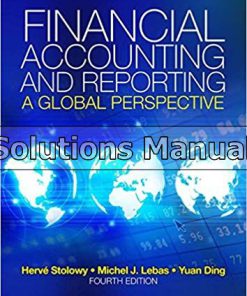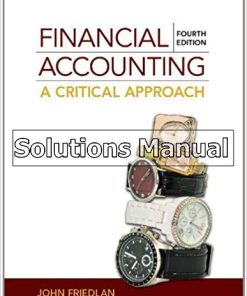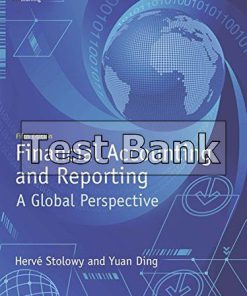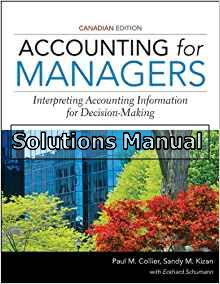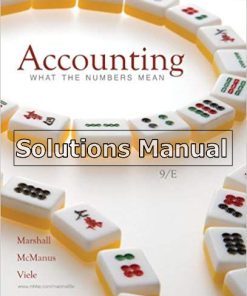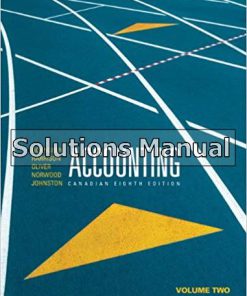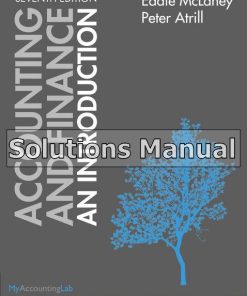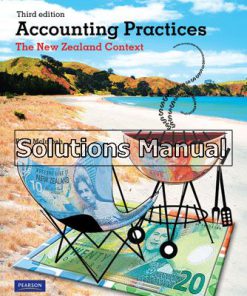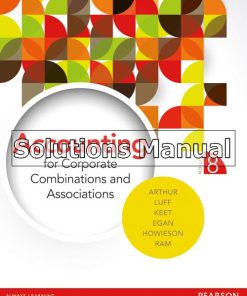Financial Accounting A User Perspective Canadian 6th Edition Hoskin Solutions Manual
$50.00 Original price was: $50.00.$26.50Current price is: $26.50.
Financial Accounting A User Perspective Canadian 6th Edition Hoskin Solutions Manual.
Financial Accounting A User Perspective Canadian 6th Edition Hoskin Solutions Manual
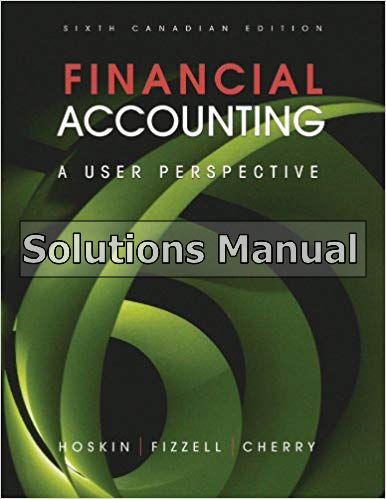
Product details:
- ISBN-10 : 0470676604
- ISBN-13 : 978-0470676608
- Author: Robert E. Hoskin
Financial Accounting: A User Perspective, Sixth Canadian Edition maintains its unique focus on the users of accounting information while presenting accounting concepts in a traditional framework. Students learn about underlying accounting concepts and accounting systems and get to apply that information from a user perspective. Unlike other books, Financial Accounting uses the analysis of real companies’ financial information as the focal point for the user perspective. This unique approach has allowed all students, majors and non-majors alike, to gain the solid understanding of accounting that they will need to succeed in business. The text, paired with WileyPLUS, forms a strong teaching and learning package.
Table contents:
- Chapter 1: Overview of Corporate Financial Reporting
- What is a Business?
- What is Accounting?
- Forms of Organization
- Users of Financial Statements
- Internal Users
- External Users
- Development of Accounting Standards
- Qualitative Characteristics and Constraints of Accounting Information
- Business Activities
- Financing Activities
- Investing Activities
- Operating Activities
- H&M Annual Report
- Corporate Profile
- Message to Shareholders
- Management Discussion and Analysis
- Board of Directors and Management
- Financial Section
- Summary
- Chapter 2: Analyzing Transactions and Their Effects on Financial Statements
- User Relevance
- The Basic Accounting Equation
- Transaction Analysis and the Basic Accounting Equation
- Sample Transactions
- Transaction Analysis
- Financial Statements
- Statement of Earnings
- Statement of Financial Position
- Variations in Statement of Financial Position Presentation
- Using Ratios to Analyze Financial Statements
- Profitability Ratios
- Statement of Cash Flows
- Summary
- Chapter 3: Processing Data Through the Accounting System
- User Relevance
- Double-Entry Accounting Systems
- Debits and Credits
- Statement of Financial Position
- Understanding the Accounting Cycle
- The Chart of Accounts
- The Opening Balances
- Transactions
- Analyzing Transactions
- Recording Transactions in a Journal
- Recording in Journal, Ledger, and Trial Balance
- Posting to the Ledger
- Preparing a Trial Balance
- Recording Adjusting Entries
- Preparing an Adjusted Trial Balance
- Preparing Financial Statements and Closing Entries
- Preparing the Financial Statements
- Preparing the Closing Entries
- Accounting Cycle Frequency
- Summary
- Chapter 4: Revenue Recognition and Statement of Earnings
- User Relevance
- Cash-to Cash Cycle
- Cash
- Acquisition of Inventory
- Selling Activity
- Delivery of Product
- Collection
- Warranty Service
- Summary of the Cash-to-Cash Cycle
- Revenue Recognition
- Earnings Management
- Applications of Revenue Recognition
- Revenue Recognized from Multiple Lines of Business
- Statement of Earnings Format
- Earnings from Operations
- Earnings from Non-Operating Sources
- Earnings from Unusual or Infrequent Events
- Corporate Income Taxes
- Discontinued Operations
- Variations in Statement of Earnings Formats
- Examples of Actual Statements of Earnings
- Earnings Per Share
- Comprehensive Income
- Performance Measurement
- The Return on Investment (ROI) Ratio as a Measure of Performance
- Net Earnings as a Measure of Performance
- Summary
- Chapter 5: The Statement of Cash Flows
- User Relevance
- Why Another Flow Statement?
- Ajax Company Example
- Performance Evaluation Using the Statement of Earnings and Statement of Cash Flows
- Solutions to the Cash Flow Problem
- Understanding the Statement of Cash Flows
- Definition of Cash and Cash Equivalents
- Components of Cash Flows
- Financing Activities
- Investing Activities
- Operating Activities
- Preparing the Statement of Cash Flows
- An Intuitive Approach to the Preparation of a Statement of Cash Flows
- Determining the Cash Flows from Operating Activities
- Determining the Cash Flows from Financing and Investing Activities
- Interpreting Cash Flow Information
- An Analysis of Le Château’s Statement of Cash Flows
- Summary
- Reading and Interpreting Published Financial Statements
- Integrative Questions on Chapters 1–5
- Chapter 6: Cash, Short-Term Investments, and Accounts and Notes Receivable
- User Relevance
- Cash
- Cash Valuation Methods
- What Is Canadian Practice?
- Internal Control and Cash Management
- Bank Reconciliations
- Statement Analysis Considerations
- Short-Term Investments
- Valuation Methods
- What Is Canadian Practice?
- Initial Acquisition
- Dividend and Interest Recognition
- Recognition of Gains and Losses
- Accounts Receivable
- Accounts Receivable Valuation Methods
- What Is Canadian Practice?
- The Allowance Method of Accounting for Bad Debts
- Estimating Bad Debts under the Allowance Method
- The Direct Write-Off Method of Accounting for Bad Debts
- Notes Receivable
- Types of Notes Receivable
- Interest on Notes Receivable
- Statement Analysis Considerations
- Short-Term Liquidity
- Current Ratio
- Quick Ratio
- Accounts Receivable Turnover Ratio
- Summary
- Chapter 7: Inventory
- User Relevance
- Examples of Inventory
- Inventory Recognition and Cost of Goods Sold
- Valuation Criteria
- Historical Cost
- Market Value
- What Is Canadian Practice?
- Acquisition Costs
- Lower of Cost and Net Realizable Value
- Inventory Systems
- Perpetual Inventory Systems
- Periodic Inventory Systems
- Cost and Benefits of System Choice
- Cost Flow Assumptions
- First-In, First-Out (FIFO)
- Moving Average
- Cost Flow Assumption Choice
- Inventory Issues for Management
- Inventory Estimation
- Using the Cost-to-Sales Ratio
- Statement Analysis Considerations
- Inventory Turnover
- Other Ratios
- Summary
- Appendix—Cost Flow Assumptions Under the Periodic Inventory System
- Chapter 8: Capital Assets—Tangible and Intangible
- User Relevance
- Capital Asset Recognition
- How Are Capital Assets Valued?
- Historical Cost
- Market Value
- What Is Canadian Practice?
- Capitalizable Costs
- Interest Capitalization
- Depreciation Concepts
- Depreciation Methods
- Straight-Line Method
- Units-of-Activity or Production Method
- Accelerated or Declining-Balance Method
- Recording Depreciation Expense
- Corporate Income Taxes
- Choice of Depreciation Method
- Changes in Depreciation Estimates and Methods
- Additional Expenditures on Capital Assets During Their Lives
- Writedowns and Disposals of Property, Plant, and Equipment
- Natural Resources
- Intangible Assets
- Advertising
- Patents, Trademarks, and Copyrights
- Goodwill
- Comprehensive Example of Capital Asset Disclosures
- Statement Analysis Considerations
- Using the Return on Assets (ROA) Ratio
- Summary
- Chapter 9: Current Liabilities, Contingencies, and Commitments
- User Relevance
- Recognition Criteria and Liabilities
- Valuation Methods for Liabilities
- What Is Canadian Practice?
- Current Liabilities
- Current Liabilities Related to Operating Activities
- Current Liabilities Related to Financing Activities
- Statement Analysis Considerations
- Contingencies
- Commitments
- Summary
- Chapter 10: Long-Term Debt and Other Non-Current Liabilities
- User Relevance
- Long-Term Notes and Mortgages
- Long-Term Loans with Equal Blended Monthly Payments
- Long-Term Loans with Monthly Payments of Interest Only
- Bonds and Debentures
- Basic Bond Characteristics
- Bond Pricing in the Marketplace
- Calculating Bond Interest Expense and Liability Balances
- Accounting for Bonds
- Repayment of Bonds at Maturity
- Early Retirement of Debt
- Long-Term Notes or Bonds with No Explicit Interest
- Leases
- Classification of Leases
- Accounting for Leases
- Pensions
- Defined Contribution Pension Plans
- Defined Benefit Pension Plans
- Pension Plan Disclosures
- Other Post-Employment Benefits
- Deferred Income Taxes
- Other Income Tax Disclosures
- Statement Analysis Considerations
- Summary
- Appendix—Using Excel to Calculate Present Value
- Chapter 11: Shareholders’ Equity
- User Relevance
- Form of Organization
- Sole Proprietorship
- Partnership
- Corporation
- Limited Liability Differences in the Different Forms of Organization
- Taxation Differences in the Different Forms of Organization
- Other Advantages and Disadvantages of the Different Forms of Organization
- Corporations
- Shares
- Common Shares
- Preferred Shares
- Accounting for the Issuance of Common Shares
- Repurchased Shares
- Dividends, Stock Splits, and Employee Stock Options
- Cash Dividends
- Property Dividends
- Stock Dividends
- Stock Splits
- Employee Stock Options
- Statement of Retained Earnings and Statement of Changes in Equity
- Statement of Retained Earnings
- Statement of Changes in Equity
- Financial Statement Analysis
- Book Value and Market Value
- Price/Earnings Ratio
- Return on Shareholders’ Equity Ratio
- Summary
- Appendix—Repurchase of Shares and Treasury Shares
- Applying Your Knowledge and a User Perspective
- The Impact of Accounting Policy Choices on Financial Statements—An Integrative Project
- Chapter 12: Financial Statement Analysis
- User Relevance
- Overview of Financial Statement Analysis
- Understanding the Business
- Reading the Financial Statements
- Retrospective versus Prospective Analysis
- Time-Series versus Cross-Sectional Analysis
- Data to Be Used
- Ratios
- Profitability Ratios
- Short-Term Liquidity Ratios
- Activity Ratios
- Solvency Ratios
- Equity Analysis Ratios
- Non-Manufacturing or Non-Retail Company Analysis
- Interpreting the Ratios
- Summary
- Appendix A: H&M Annual Report
- Appendix B: Accounting for Intercompany Investments
- Subject Index
- Company Index
- Photo Credits
People also search:
financial accounting users
financial accounting canadian edition pdf
financial accounting canadian edition
financial accounting 6th canadian edition solutions pdf
financial accounting 7th canadian edition answer key
Instant download after Payment is complete
You may also like…
Solutions Manual
Financial Accounting and Reporting a Global Perspective 4th Edition Stolowy Solutions Manual
Solutions Manual
Financial Accounting A Critical Approach Canadian 4th Edition Friedlan Solutions Manual
Canadian
Community Health Nursing A Canadian Perspective Canadian 4th Edition Stamler Solutions Manual
Solutions Manual
Financial Accounting and Reporting A Global Perspective 5th Edition Stolowy Test Bank
Canadian
eBusiness A Canadian Perspective for a Networked World Canadian 4th Edition Trites Solutions Manual
Related products
Solutions Manual
Accounting Volume 2 Canadian 8th Edition Horngren Solutions Manual
Solutions Manual
Solutions Manual
Solutions Manual




